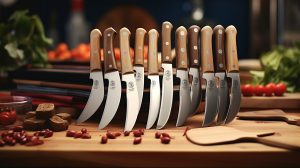Welcome to our article on whether you can use kitchen scissors for a haircut. We all have those moments when we need a quick trim or touch-up, and the first thing we might reach for is a pair of scissors from the kitchen. But is it safe or practical to use these scissors for cutting hair?
In this article, we’ll delve into the advantages, potential drawbacks, and alternative options to provide you with the information needed to make a well-informed choice.
Key Takeaways:
- Using kitchen scissors for a haircut is not recommended due to factors such as precision and design.
- Specialized haircutting scissors are the preferred tool for a professional and safe haircut.
- Consulting a skilled hair stylist is recommended for the best haircutting results.
- If you prefer DIY haircutting, alternative tools and accessories are designed explicitly for haircutting.

Using Kitchen Scissors for Hair Cutting
Many of us have been in a pinch before and had to resort to using household scissors for a quick trim or cut. However, using kitchen scissors for cutting hair is not recommended, and several reasons exist.
Kitchen scissors are typically designed for cutting food, and their blades may need to be more sharp or precise for hair cutting. Additionally, kitchen scissors’ shape and size may differ for the various angles and techniques required for hair cutting.
While kitchen scissors may seem like a convenient option, they can lead to uneven cuts, split ends, and damage to the hair. Your hair will likely look healthier and more polished if you invest in a pair of professional haircutting scissors or seek the expertise of a skilled hairstylist.
Using Kitchen Shears for Hair Cutting
Some people may confuse kitchen shears with kitchen scissors and wonder if they can be used for haircutting. However, kitchen shears are specifically designed for cutting food, and their blades may need to be more sharp or precise for hair cutting.
If you need a quick fix, kitchen shears may be better than kitchen scissors. However, it’s still recommended to use specialized haircutting scissors for the best results.
Benefits of Using Kitchen Scissors for Hair Cutting
While we do not recommend using kitchen scissors for cutting hair, there are some potential benefits.
| Benefit | Description |
|---|---|
| Convenience | Kitchen scissors are likely readily available in your home, making them a convenient option for an impromptu haircut. |
| Cost-effective | Compared to purchasing a specialized tool, kitchen scissors can be a more cost-effective option for those on a budget. |
| Versatility | Kitchen scissors may have multiple uses beyond cutting food, making them a versatile tool for your household. |
It’s important to remember that while these benefits may seem appealing, using kitchen scissors for a haircut can have severe consequences. We recommend exploring alternative options for haircutting to ensure safe and satisfactory results.
Risks of Using Kitchen Scissors for Hair Cutting
While using household scissors for a haircut may seem like an intelligent option, it’s essential to consider the potential risks involved.
Firstly, kitchen scissors are not designed for haircutting. They need to gain the precision and sharpness required for a clean and even cut, which can result in uneven strands, split ends, and an overall unprofessional look.
Furthermore, kitchen scissors might not undergo proper sanitization, thereby elevating the potential for infection and the transmission of germs. This can be especially concerning if you are cutting someone else’s hair.
Finally, household scissors may not have the necessary safety features, such as rounded tips and protective guards, which can prevent accidental cuts and injuries.
“Using kitchen scissors for hair cutting is dangerous and can cause irreparable damage to your hair and scalp. Please do not attempt it.”
While kitchen scissors may seem convenient, they present several risks and drawbacks that make them unsuitable for haircutting. Investing in professional haircutting scissors or consulting a skilled hair stylist for optimal results is best.
Alternatives to Using Kitchen Scissors for Hair Cutting
If you’ve decided that using kitchen scissors for a haircut isn’t the best option, don’t worry – there are several alternatives to consider.
Here are a few options:
| Tool | Description |
|---|---|
| Professional Hair Cutting Scissors | These are specialized scissors designed for cutting hair, with sharp, precise blades and comfortable handles. They are available in different sizes and shapes to suit other cutting techniques. |
| Hair Clippers | These are electric or battery-powered devices with blades that cut hair with a comb attachment. They are ideal for short haircuts and can create a uniform length. |
| Razor Blades | These sharp blades can be used to create textured or layered haircuts. They require some skill and practice to use effectively. |
Each tool has advantages and drawbacks, so it’s crucial to consider your requirements and inclinations when selecting the most suitable option.
Additional Tips:
- Research and invest in a quality tool that will last longer and provide better results.
- Consult a professional stylist or barber for recommendations on suitable tools and techniques.
- Practice on mannequin heads or small sections of hair before attempting a full haircut.
By exploring these alternatives and choosing the right tool, you can achieve a satisfying haircut without using kitchen scissors.
Using Kitchen Shears for Hair Cutting
While similar in appearance, kitchen shears and kitchen scissors have some essential differences that make them better suited for different tasks. Kitchen shears are explicitly designed for cutting food, whereas kitchen scissors offer greater versatility, serving multiple purposes around the house.
When it comes to cutting hair, it’s essential to use a tool that is specifically designed for the task. While kitchen shears may seem viable, they require more precision and sharpness for a clean, even cut.
Additionally, the blades of kitchen shears are often curved or angled, making it difficult to achieve a straight cut. This can result in uneven or choppy hair, different from the desired outcome.
Therefore, we do not recommend using kitchen shears for cutting hair. Instead, invest in professional haircutting scissors or consult a skilled hair stylist for the best results.
Professional Hair Cutting Scissors vs. Kitchen Scissors
Understanding the differences between professional haircutting scissors and kitchen scissors is essential. While kitchen scissors may seem convenient and cost-effective, they require more precision and design for hair cutting.
Professional haircutting scissors are designed specifically for cutting hair, with sharp blades and ergonomic handles that provide control and comfort. They come in various sizes and styles to suit different cutting techniques and hair types.
The Key Differences
| Professional Hair Cutting Scissors | Kitchen Scissors |
|---|---|
| Sharp, precise blades | Blunt blades that may damage hair |
| Ergonomic handles for comfort and control | Straight handles that may cause hand fatigue |
| Available in a range of sizes and styles | One-size-fits-all design |
Using kitchen scissors for cutting hair can also pose safety risks. The blunt blades and straight handles may cause hair to slip or pull, resulting in uneven or jagged cuts and potential injury to the scalp or fingers.
Professional haircutting scissors are an investment in your hair’s health and appearance. Crafted for durability, they can be regularly honed to preserve their sharpness and efficiency.
Investing in a good pair of professional haircutting scissors is essential if you’re serious about cutting hair.
How to Choose the Ideal Hair Cutting Scissors
Investing in a pair of haircutting scissors can make all the difference. Here are some tips on how to choose the right ones for your needs:
- Consider the size and weight: Haircutting scissors come in different sizes and weights. Opt for a size and weight that offers a comfortable grip, which will impact your control and accuracy during usage.
- Look for high-quality materials: Haircutting scissors are often made of stainless steel or titanium. Both materials are durable and long-lasting, but titanium is lighter and more resistant to rust and corrosion.
- Check the blade type: There are two types of blades: beveled and convex. Beveled edges are more common and affordable, but convex blades are sharper and require less cutting force.
- Decide on the blade length and teeth: Blade length can range from 5.5 to 7 inches, with longer blades offering better control and precision. Teeth, or notches, can be added to the edge to thin out hair and create texture, but they are not necessary for basic cuts.
- Consider your hair type: Different hair types require different scissors. For example, curly hair may benefit from scissors with wider teeth or a serrated blade, while fine hair may require a sharper edge for clean cuts.
- Get professional advice: If you need help deciding which scissors to choose, consult a professional hair stylist or barber. They can recommend a pair of scissors based on your hair type and cutting needs.
Choosing the right haircutting scissors can make a big difference in achieving a successful haircut. Take the time to research and invest in a high-quality pair that meets your needs.
Maintaining and Sharpening Hair Cutting Scissors
Proper maintenance and sharpening are crucial to keep haircutting scissors in optimal condition. Dull scissors can lead to uneven and messy cuts, so inspecting and sharpening them regularly is essential.
Here are some tips for maintaining and sharpening haircutting scissors:
- Clean after every use: Wipe the blades with a clean cloth or tissue after each use to remove any hair or product buildup.
- Oil regularly: Apply a few drops to the blades to prevent rust and promote smooth cutting. Use a specialized scissor oil instead of household lubricants, which can damage the scissors.
- Inspect for damage: Frequently inspect the blades and screws for indications of damage or deterioration. Should you observe any concerns, contact a professional for the necessary repairs or replacements.
- Sharpen when needed: Depending on usage, haircutting scissors should be sharpened at least once every six months. You can send them to a professional sharpening service or invest in a sharpening tool and point them yourself.
When sharpening haircutting scissors, it’s essential to follow these guidelines:
- Use the right tool: Use a sharpening stone or diamond abrasive tool designed explicitly for haircutting scissors. Household sharpeners or files can damage the scissors.
- Angle the blades: Hold the scissors at a 45-degree angle while sharpening to maintain the original cutting angle.
- Alternate sides: Sharpen each blade alternately to ensure a balanced edge.
- Precision over speed: Take your time and focus on accuracy rather than speed. Rushing can lead to mistakes and uneven sharpening.
By maintaining and sharpening your haircutting scissors regularly, you can ensure a smooth and precise cut every time.
Finding a Professional Hair Stylist
At times, cutting your hair may not be the best option. If you’re looking for a more skilled and professional haircutting experience, it’s best to seek the help of a professional hairstylist. However, finding the right one can be challenging. Here are some tips to help you:
- Ask for recommendations from friends and family members who have a hairstyle you admire.
- Examine online feedback and ratings on platforms such as Yelp and Google.
- Look for stylists who specialize in the type of hair you have.
- Consider the location of the salon and its proximity to your home or workplace.
It’s also a good idea to schedule a consultation with the stylist before you commit to a haircut. This will allow you to discuss your hair type, style preferences, and concerns.
DIY Hair Cutting Tips and Tricks
At-home haircuts can be nerve-wracking; however, employing appropriate tools and methods can lead to a gratifying outcome. Here are some tips and tricks we’ve learned to make the process a little less intimidating:
- Start small: If you’re new to haircutting, start with small trims and work up to more significant changes.
- Use sharp scissors: Dull scissors can cause split ends, so ensure your scissors are strong and in good condition.
- Section your hair: Divide your hair into small sections and work on one at a time. This will ensure a more even cut.
- Don’t cut too much: Remember, you can always cut more later, so start with less and work your way up.
- Cut in a straight line: Use your fingers as a guide and cut in a straight line. Avoid cutting at an angle or in a zig-zag pattern.
With these tips in mind, you can tackle your at-home haircuts confidently. But remember, if you’re uncomfortable cutting your hair, it’s always best to seek the help of a professional.
Common Mistakes to Avoid When Cutting Hair at Home
At-home haircutting can be a tricky task, especially for beginners. Here are some common mistakes to avoid:
- Rushing: Take your time and follow a plan before starting to cut. It’s better to take more time now than to regret it later.
- Skipping Sections: Make sure to section off your hair properly before cutting. Ignoring sections can lead to uneven cuts and messy results.
- Using Dull Scissors: Always use sharp scissors for cutting hair. Dull scissors can damage the hair and lead to split ends.
- Cutting Wet Hair: Cutting wet hair can result in a shorter cut than intended. Dry the hair thoroughly before starting to thin.
- Not Consulting a Reference: If you need more clarification about the length or style you want to achieve, consult a reference image. This will help you visualize the result and plan accordingly.
- Not Trimming Regularly: Regular trimming is essential for maintaining healthy hair. Take your time between haircuts, leading to split ends and damage.
You’ll be on your way to a successful home haircut by avoiding these common mistakes. Should you have any uncertainties about any aspect of the procedure, seek guidance from a seasoned hair stylist.
You’re a Successful Home Hair Cut
If you’re pladon’t to cut your hair at home, there are several things you can do to ensure a successful outcome. You’re some tips:
- Plan: Before cutting your hair, ensure you have all the necessary tools and products. This includes a mirror, haircutting scissors, hair clips, a comb, and any styling products you plan to use.
- Clean and dry hair: Ensure your hair is clean and fully dry before cutting. Wet hair can prove more challenging to cut and style with precision.
- Start small: It’s always better to cut off too little hair than too much. Start with small snips and work your way up as needeIt’section your hair: Partition your hair into segments to simplify the cutting process. Use hair clips to secure each section, and work on one area at a time.
- Cut in small increments: Instead of trying to cut a large amount of hair at once, make minor cuts and examine your progress as you go.
- Use a mirror: Make sure you have a mirror in front of you so you can see what you’re doing. Use a second mirror or have someone else check the back of your head.
- Take a break: Trimming your hair alone can be taxing, so pause when necessary to allow your arms and hands to rest.
- Style as desired: Once you’ve finished cutting your hair, style it as desired. Use any styling products you have, and don’t be afraid to move.
With these tips in mind, you can achieve a successful home haircut. Just rememberdon’take your time and be patient with yourself. And if you need more clarification or are happy with the results, it’s always best to seek the help of a professional hairstylist.
DIY you getting Tools and Accessories
Having the right tools and accessories is crucial for those committed to cutting their hair. Here are some essential items to consider:
| Tool/Accessory | Description |
|---|---|
| Professional hair-cutting scissors | Investing in a high-quality pair of scissors designed for cutting hair is essential. They will ensure a clean and precise cut, reducing the risk of damage or uneven results. |
| Clippers | Clippers can be valuable and time-saving if you prefer shorter haircuts or need to trim your hair frequently. Look for a versatile set with adjustable guards and multiple blade lengths. |
| Comb | A sturdy and durable comb with fine teeth can help section and detangle hair, making it easier to cut and style. |
| Mirror | A large and well-lit mirror is essential for a successful home haircut. Consider investing in a wall-mounted mirror or a handheld one that can be adjusted to different angles. |
| Hair clips or ties | Keeping hair out of the way during a haircut is essential for achieving precise results. Stock up on hair clips or ties to ensure that your hair is secured and not interfering with the cutting process. |
| Styling products | After cutting your hair, you may want to style it in a specific way. The right styling products, such as gel, wax, or mousse, can help you achieve the desired look. |
Remember that employing the appropriate tools and accessories can significantly influence the final results of your at-home haircut. Feel free to invest in quality items that will help you achieve the best results.
Pros and Cons of Cutting Don’twith Kitchen Scissors
It was using kitchen scissors for a haircut conscious and cost-effective. Nonetheless, it’s important to weigh both the advantages and disadvantages before arriving at a decision.
| Pros | Cons |
|---|---|
| Convenient: Kitchen scissors are readily available in most households. | Lack of precision: Kitchen scissors are not specifically designed for hair cutting, which means they lack the precision needed for an even and professional-looking haircut. |
| Cost-effective: If you’re on a tight budget, using kitchen scissors may seem an excellent way to save money on haircuts. | Potential risks: Kitchen scissors may not be sterilized, which can increase the risk of infections. They can also cause split ends, hair damage, and uneven cutting, which may require costly repairs. |
| Familiarity: If you’re used to using kitchen scissors for other purposes, you may also feel comfortable using them for haircutting. | Unprofessional appearance: A haircut with kitchen scissors may not have a professional appearance, affecting your self-confidence and how others perceive you. |
Overall, using kitchen scissors for haircutting is not recommended, as the cons outweigh the pros. However, if you use them, ensure they are sterilized and sharpened. For optimal outcomes, it’s recommended to consult with a professional hair stylist or consider acquiring a pair of specialized haircutting scissors.
Conclusion
After exploring the idea of using kitchen scissors for a haircut, we can conclude that it is not recoIt’sded. While kitchen scissors may seem like a convenient option, they need more design and precision for hair cutting.
Investing in professional haircutting scissors or consulting a skilled hair stylist is the best option for achieving satisfactory results. Professional haircutting scissors are designed for haircutting and provide better control and accuracy.
If you prefer, Plenty of alternatives are available if you cut your hair, Plenty of haircutting scissors and clippers. It’s important to choose the right tool for your needs and to practice proper techniques to avoid common mistakes.
While it may be tempting to use household scissors for a haircut, it’s important to prioritize your hair’s health and invest in the necessary tools and expertise for optimal results.
FAQ
Q: Can you use kitchen scissors for a haircut?
A: Using kitchen scissors for a haircut is not recommended. Kitchen scissors are designed for cutting food and lack the design required for hair cutting. Using specialized haircutting scissors or consult a professional hair stylist is best.
Q: What are the benefits of using kitchen scissors for haircutting?
A: While using kitchen scissors for haircutting may seem convenient, it is important to consider the risks involved. Kitchen scissors are not specifically designed for hair cutting and may result in uneven cuts or potential injuries.
Q: What are the risks of using kitchen scissors for haircutting?
A: Using kitchen scissors for haircutting can be risky. Insufficient blade sharpness could result in uneven cuts or hair damage. Additionally, the design of kitchen scissors may cause discomfort or injury during the cutting process.
Q: What are the alternatives to using kitchen scissors for haircutting?
A: Several alternatives are available if you prefer not to use kitchen scissors for haircutting. Specialized haircutting scissors are designed for precision and control, ensuring better results. Additionally, consulting a professional hair stylist is always a reliable option.
Q: Can kitchen shears be used for haircutting?
A: Kitchen shears, specifically designed for cutting food, may seem similar to kitchen scissors. However, they are not recommended for haircutting as they need more precision and the design of specialized haircutting scissors.
Q: What are the differences between professional haircutting scissors and kitchen scissors?
A: Professional haircutting scissors are specially designed for hair cutting, with sharp blades and ergonomic handles for comfort and control. On the other hand, kitchen scissors are designed for cutting food and lack the necessary features for precision hair cutting.
Q: How do I choose the right haircutting scissors?
A: When choosing haircutting scissors, consider factors such as blade material, handle design, and size. It is important to select scissors that are comfortable to hold and offer the desired level of sharpness and control.
Q: How do I maintain and sharpen haircutting scissors?
A: Proper maintenance and sharpening are essential to keep haircutting scissors in optimal condition. Regular cleaning, lubrication, and occasional sharpening can ensure longevity and functionality.
Q: How can I find a professional hair stylist?
A: To find a professional hair stylist, consider seeking suggestions from friends or family, perusing online reviews, or visiting reputable salons. Choosing a stylist with the expertise and experience is essential to meet your haircutting needs.
Q: What are some DIY haircutting tips and tricks?
A: For those who prefer DIY hair cutting, here are some useful tips and tricks to consider: properly sectioning the hair, using sharp scissors, cutting small sections at a time, and checking for symmetry throughout the process.
Q: What are common mistakes to avoid when cutting hair at home?
A: When cutting hair at home, it is important to avoid common mistakes such as cutting too much hair at once, using dull scissors, not following a guide or reference, and not taking enough time to ensure accurate results.
Q: What are some tips for a successful home haircut?
A: To achieve a successful home haircut, consider the following tips: start with clean and dry hair, use a good mirror and adequate lighting, follow a step-by-step guide or tutorial, and take your time to ensure accuracy and precision.
Q: What are essential DIY haircutting tools and accessories?
A: Some essential tools and accessories for DIY hair cutting include sharp haircutting scissors, a fine-toothed comb for sectioning, hair clips for holding sections, and a spray bottle for misting the hair.
Q: What are the pros and cons of cutting hair with kitchen scissors?
A: The pros of cutting hair with kitchen scissors include convenience and cost-effectiveness. However, the cons include the lack of precision, potential damage to the hair, and the risk of injury. It is generally recommended to use specialized haircutting scissors or consult a professional.

It’s me, Amber Hayden, the heart and soul behind SagarmathaOnlineMedia.com. From a young age, I’ve been head over heels for everything home-related, from interior decor to gardening. I’m the type who can’t resist a well-crafted piece of furniture, and I firmly believe that a home isn’t complete without a pet or two. But it’s not just about creating pretty spaces for me. I’m all about making homes that tell a story reflecting the people living there. SagarmathaOnlineMedia.com is my way of sharing this passion with you. Whether you’re looking for tips to jazz up your living room, advice on pet care, or ideas to make your garden bloom, I’m here to help. So, let’s embark on this journey together and make your house a home!



